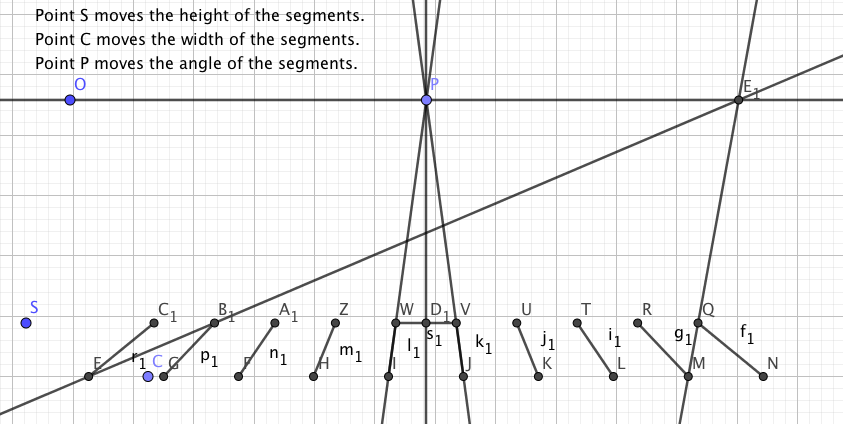Mathematical Art Against Hate: Which Side Are You On?
Written by: Dr. Julian Fleron.
Perspective, Perception and Geometry
In the fall of 2017 I used Discovering the Art of Mathematics: Geometry as the focus on my Mathematical Explorations course, a core mathematics course for a general audience. The text lead us through explorations of perspective drawing, perception, visualization, how to render 3-dimensional objects in 2-dimensions and the interplay between the dimensions. We thought a great deal about how different ways of visualizing gives us different perspectives on what we see.
One day I taped large, interactive, two-dimensional images on the boards. (See image below.)
Students were amazed to discover that if you put yourself in the right position, all of these images appeared as identical looking cubes. (To see it yourself, see video below, starting at minute 4:30.)
The students were still standing up, milling about when it became clear it was about time to leave. They started to pack up.
But I still had part of the lesson to finish. I walked up to one student, puffed myself up and said, sternly, "Is that racism?’’ A hush fell over the class. I got in the face of another student, "Is that sexual harassment?’’ Another, "Is that bullying?’’ Another, "Is that discrimination?’’ Another, "Is that hate?’’ Silence and shock. I backed up and asked a final question, "Does it matter where you are standing?’’
It was a profound moment. Students exclaimed, made a variety of mind blowing up gestures and then forgot all about it being time to go, instead sitting back down and discussing what had happened.
Mathematical Art Against Hate
There’d been some incidents of intolerance on our campus during the semester. When I came into the very next class the students took over. There was a chorus of "We want to do something like this to address the issues on campus and that we see in the news all of the time.’’
So that’s what we did for the last month of the semester. We created, invented and explored different ways that we could use mathematical art to make statements about hatred and intolerance. At the end of the course students presented their ideas and small proof of concept models. Sadly, we didn’t have time or resources to create large-scale models.
Mathematical Art Against Hate: Which Side Are You On?
Luckily, there was interest in continuing among some of the students.
Several of the fall models provided the impetus for the design and realization of Mathematical Art Against Hate: Which Side Are You On? which was created in the spring.
This piece of mathematical art dynamically shows humanity centered between the poles of tolerance, respect, equality, justice, freedom,… on one side and hate, oppression, discrimination, bias, bullying,… on the other.
The goal of the piece is to get people to think:
- Which Side Are You On?
- Where are you standing?
- Does your perspective inform how you think about certain issues, about how you see the world?
Read the full Artists’ Statement .
Mathematical Aspects
This type of geometrical art is called lenticular art.  Each of the hanging panels is a different width. They are foreshortened to make the complete perspective image continuous to the eye. We used both SketchUp and GeoGebra to model the piece of art and to determine appropriate scales, viewing angles and positions and absolute sizes for all of the different pieces. For example, consider this dynamic GeoGebra design document. We used Photoshop, InDesign and Illustrator for the graphics.
Each of the hanging panels is a different width. They are foreshortened to make the complete perspective image continuous to the eye. We used both SketchUp and GeoGebra to model the piece of art and to determine appropriate scales, viewing angles and positions and absolute sizes for all of the different pieces. For example, consider this dynamic GeoGebra design document. We used Photoshop, InDesign and Illustrator for the graphics.
Impact
Way too many people say they are not good at math. They say that they don’t like it. Many feel inferior because of that. In our course Mathematical Explorations, where we have a lot of students like that, it is wonderful to see them overcome these negate perceptions and self-images. It is liberating to see them discover that mathematics is something completely different than what they thought it was. Inspiring to have them see that it is an art that is all around them in the way we visualize the world, that mathematics is part of the psychology of the interaction between our brain and our senses.
In the context of the intolerance and bullying that we find ourselves surrounded by many of us feel powerless of. We don’t know what to do to effect real change.
So here are these 18 and 19 year-old students just arriving at college, in a mathematics class they don’t want to be in, that they think they are not going to like and they are face to face with issues of intolerance on our campus mirroring those that are sweeping our country.
Yet they chose not to be powerless.
They went and they did something. They designed these beautiful mathematical art pieces. They created powerful mathematical statements about hate and intolerance.
It was an uplifting and empowering experience for all of the students.
And to me to be able to be on this journey with these students.


